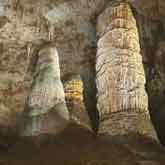A National Park of Caves
 Carlsbad Caverns National Park has been designated as a world heritage site because of its unique and surprising geology - a story more than 250 million years old that can be read both above and below ground.
Carlsbad Caverns National Park has been designated as a world heritage site because of its unique and surprising geology - a story more than 250 million years old that can be read both above and below ground.
The park is found within the Guadalupe Mountains, a limestone mountain range recognized as the best-preserved Permian-aged fossil reef in the world. The ocean fossils here reveal a detailed picture of life along a coastline of a shallow inland sea some 240 to 280 million years ago. These fossils show that the 'Capitan Reef' was built mostly of sponges and algae-not by coral like many of today’s reefs. Other marine fossils found here include ammonites, crinoids, snails, nautiloids, bivalves, brachiopods, and the occasional trilobite. This coastline eventually became a horseshoe-shaped limestone layer of rock over 1,800 feet thick, 2 to 3 miles wide and over four hundred miles long. By the end of the Permian age, the Capitan reef was covered by thousands of feet of newer sediments, burying the reef for tens of millions of years.
Local faulting and stresses of the earth’s crust, especially over the past 20 million years, has uplifted these reef sediments almost ten thousand feet. Wind, rain, snow and time eroded away the overlying younger sediments and now the ancient reef is exposed once again. The park's deep canyons and caves now provide visitors with unique opportunities to view this fossil reef from the inside. There are more than 105 known caves within the park alone - they are some of the biggest and longest caves in the world. All of them reveal a very unusual ingredient in cave dissolution (creation) - sulfuric acid.
About the Author
NPS National Parks Service
 The National Park Service is an agency of the federal government of the United States that manages all national parks, many national monuments, and other conservation and historical properties with various title designations.
The National Park Service is an agency of the federal government of the United States that manages all national parks, many national monuments, and other conservation and historical properties with various title designations.


